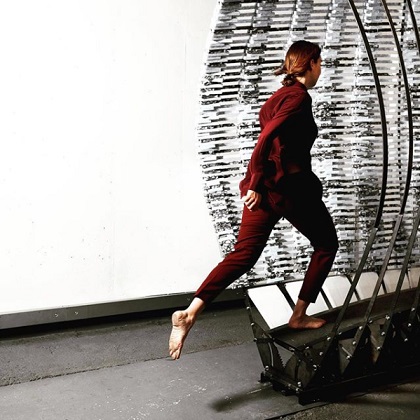Nassia Inglessis in the Department of Informatics
Working in collaboration with Dr Richard Overill, Senior Lecturer in Computer Science, Nassia Inglessis was resident in the Department of Informatics from 2017–18 on a project exploring the notion of disobedience in artificial intelligence (AI) and versions of the future where human and artificial entities coexist.
Disobedient AI
Nassia and Dr Overill used and examined the notion of disobedience as a means to engage King’s staff, students and the public with modern constructs of artificial logic and intelligence. The pair chose the notion of disobedience as they feel it is increasingly relevant in the current global political and social climate. Disobedience has become more prominent as a means for change, transformation and, the project team argue, as a means for both progress and destruction. Regardless of how it is defined, Nassia and Dr Overill feel that society cannot ignore how disobedience has become a prevalent ideology in our daily lives.
Film by Gemma Riggs
AI can be seen as an opaque notion, a ‘black box’, or even a frighteining notion of an autonomous being. With this in mind, the project team wanted to convey AI systems in a more transparent manner by developing a physical interpretation of a system that enables the public to engage with AI, or even to become one.
Some of the key questions this residency sought to explore were:
- What could disobedience in AI mean?
- In what ways can systems ‘misbehave’?
- How does disobedience manifest itself and why?
- How can disobedience be designed? How can it be controlled, accommodated or encouraged?
- Could disobedience act as a means of learning for the system?
By examining these questions, Nassia and Dr Overill designed a visualisation of the behaviour of an AI, projecting its capacity to be disobedient onto our immediate physical environment through a series of immersive installations.

Image by Luke Walker
Multi-sensorial and multi-material interactive works are an integral part of the feedback loop in Nassia’s human-centric design practice that studies logic and matter in the context of human cognition. Her installation pieces act within that process as an alternative platform for live experimentation and direct provocation. For Nassia, a crucial purpose of design is to contextualise scientific and empirical research so as to challenge predefined ideals and inspire new perspectives and prototypes of behaviour.
Nassia’s creative work provides participants with a visceral and tangible experience of AI agents by through driect interaction. The artist's immersive interactive sculpture, Disobedient AI, was displayed in the central courtyard at Somerset House during the London Design Biennale 2018 and explores inversions of the future where human and artificial entities coexist.
The outcomes of the project were showcased in the King's Artists – New Thinking, New Making exhibition in the Arcade at Bush House, 23 October – 15 December 2018.
Project team
With a technical foundation in Engineering Science from Oxford University and training in art and design from The Royal College of Art and MIT Media Lab, Nassia Inglessis is naturally driven to address technology in its etymological aspect of τέχνη (art /skill) and λογία (reason/science).
Her artistic practice spans across interaction design, cognitive and material science, biology in natural and artificial intelligence, computational design and fabrication. Her work intersects design research with public engagement through experiential installations, challenging the boundaries between designer and audience. She designs material systems and interfaces on varying scales, from wearable items to architectural installations, exploring new portals of perception as evoked through responsive matter.
As an active member of Makerversity at Somerset House, Nassia strives for an anti-disciplinary approach. She believes that impact comes through collaboration, as a way to harness diverse disciplines, skills and attitudes into a unified creative effort. She is currently is in the MIT Media Lab working with Neri Oxman and the group Mediated Matter.
Nassia has exhibited work both nationally and internationally, including at Milan Design Week in April 2017 and the Northmodern x Paris 1.618 exhibition in Copenhagen, 2016. Upcoming exhibitions include London Design Festival as part of the V&A Digital Design Weekend exhibiting a piece titled In Need of Transformation – Augmented materiality, and a work in collaboration with MIT Media Lab and Mediated Matter Group (location TBC) both in September 2017.
She is also the director of her own practice, Studio Ini.
More information about Nassia’s practice can be found on her website.
Dr Richard Overill is a Senior Lecturer in Computer Science in the Department of Informatics and a member of the Software Modelling and Applied Logic group at King’s. The Software Modelling and Applied Logic group studies modelling and engineering of software systems, and applications of logic and mathematics to computer science, artificial intelligence, information and software security, and multi-agent systems.
After obtaining his Honours BSc in Chemistry (with Astronomy and Mathematics) at the University of Leicester in 1971, Richard stayed on to do research in computational quantum theory, completing his PhD there in 1976. Between 1975 and 1987, Richard held posts in the Computing Centre, now IT Services, at King's College London and was appointed Lecturer in the Department of Informatics at King's in 1987. He became a Senior Lecturer in 1994 and his main research interests include information assurance and information warfare, cybercrime forensics and statistics, anomaly detection and intrusion detection.
Richard is a Fellow of the Higher Education Academy (FHEA), a Fellow of the British Computer Society (FBCS), a Chartered IT Professional (CITP), a Chartered Engineer (CEng), a European Engineer (EurIng), a Fellow of the Institute of Mathematics and its Applications (FIMA), a Chartered Mathematician (CMath), and a Chartered Scientist (CSci).